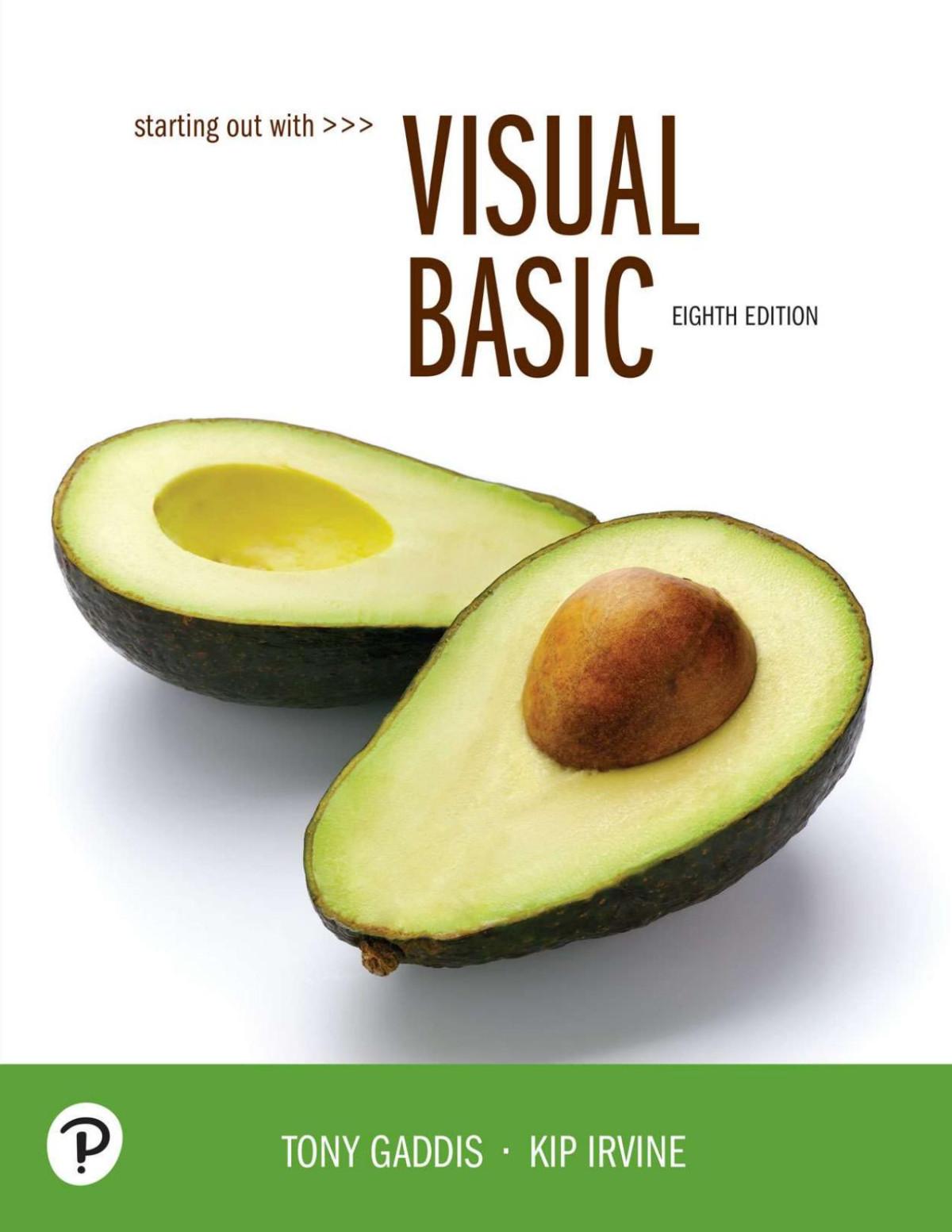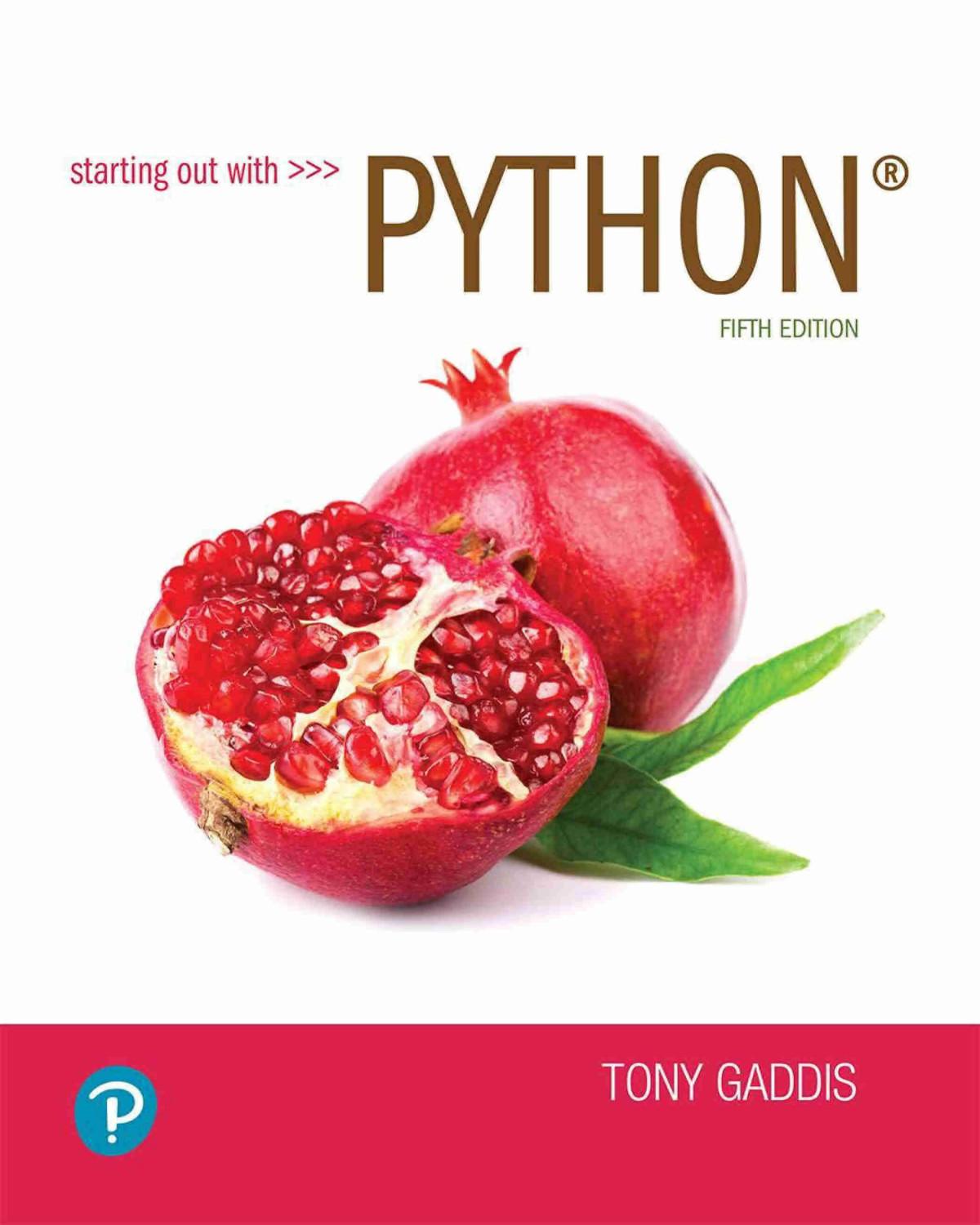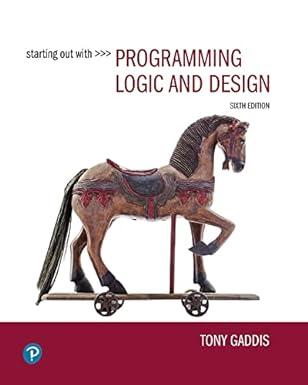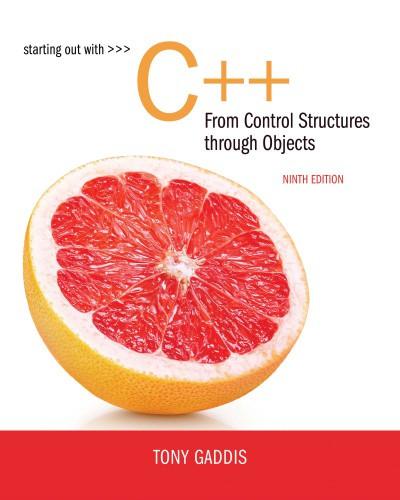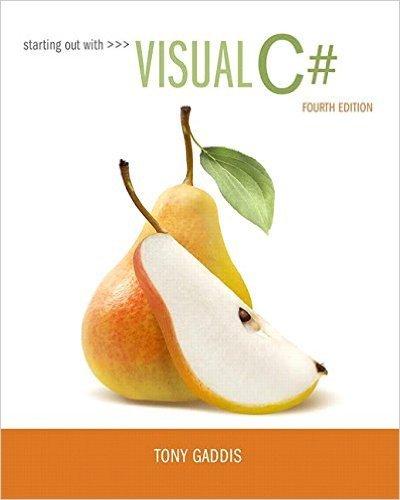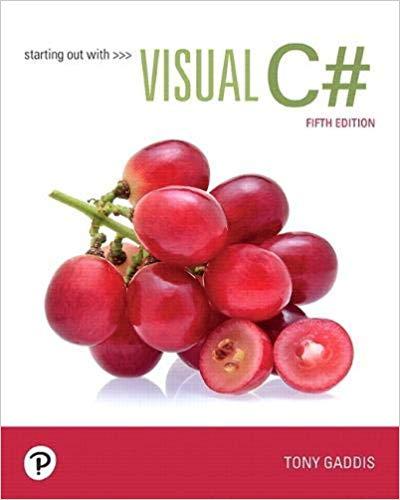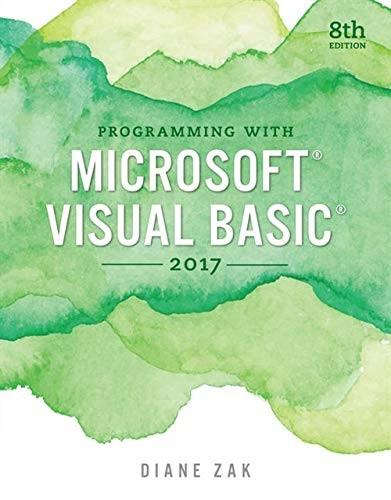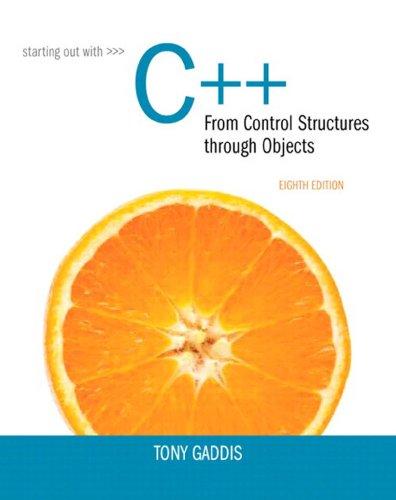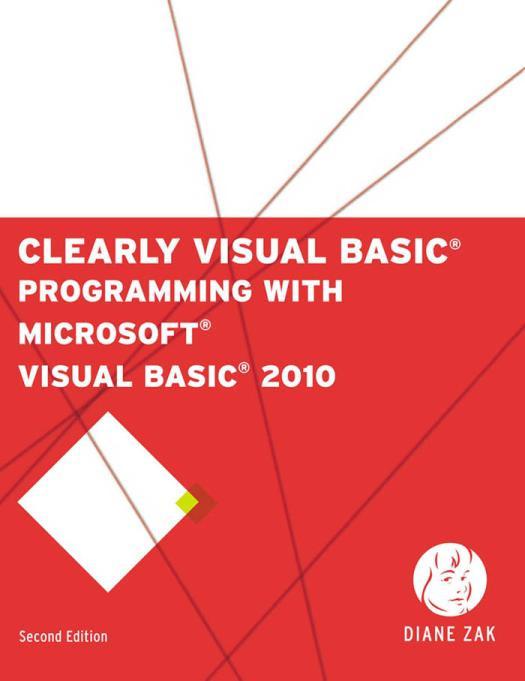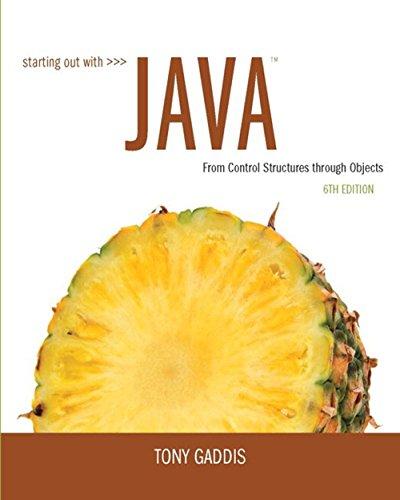Starting Out With Visual Basic
Eighth Edition
Tony Gaddis
Haywood Community College
Kip Irvine
Florida International University
Senior Vice President Courseware Portfolio Management: Marcia Horton
Vice President, Portfolio Management: Engineering, Computer Science
&Global Editions: Julian Partridge
Executive Portfolio Manager: Matt Goldstein
Portfolio Management Assistant: Meghan Jacoby
Product MarketingManager: Yvonne Vannatta
Field MarketingManager: Demetrius Hall
MarketingAssistant: Jon Bryant
ManagingProducer: Scott Disanno
Content Producer: Amanda Brands
ManufacturingBuyer, Higher Ed, Lake Side Communications, Inc. (LSC): Maura Zaldivar-Garcia
Cover Designer: Pearson CSC
Manager, Rights and Permissions: Ben Ferrini
Cover Image: matin/shutterstock
Inventory Manager: Bruce Boundy
Full-Service Project Manager: Abhishan Sharma, Integra Software Services Pvt Ltd
Composition: Integra Software Services Pvt. Ltd.
Printer/Binder: Lake Side Communications, Inc
Credits and acknowledgments borrowed from other sources and reproduced, with permission, in this textbook appear on the Credits page at the end of the text
Copyright © 2020, 2017, 2014, 2011 Pearson Education, Inc., Hoboken, NJ 07030. All rights reserved. Printed in the United States of America. This publication is protected by Copyright, and permission should be obtained from the publisher prior to any prohibited reproduction, storage in a retrieval system, or transmission in any form or by any means, electronic, mechanical, photocopying, recording, or likewise. For information regarding permissions, request forms and the appropriate contacts within the Pearson Education Global Rights & Permissions department, please visit www.pearsoned.com/permissions/.
Many of the designations by manufacturers and sellers to distinguish their products are claimed as trademarks. Where those designations appear in this book, and the publisher was aware of a trademark claim, the designations have been printed in initial caps or all caps.
The programs and applications presented in this book have been included for their instructional value. They have been tested with care, but are not guaranteed for any particular purpose. The publisher does not offer any warranties or representations, nor does it accept any liabilities with respect to the programs or applications.
MICROSOFT AND/OR ITS RESPECTIVE SUPPLIERS MAKE NO REPRESENTATIONS ABOUT THE SUITABILITY OF THE INFORMATION CONTAINED IN THE DOCUMENTS AND RELATED GRAPHICS PUBLISHED AS PART OF THE SERVICES FOR ANY PURPOSE. ALL SUCH DOCUMENTS AND RELATED GRAPHICS ARE PROVIDED “AS IS” WITHOUT WARRANTY OF ANY KIND MICROSOFT AND/OR ITS RESPECTIVE SUPPLIERS HEREBY DISCLAIM ALL WARRANTIES AND CONDITIONS WITH REGARD TO THIS INFORMATION, INCLUDING ALL WARRANTIES AND CONDITIONS OF MERCHANTABILITY WHETHER EXPRESS, IMPLIED OR STATUTORY, FITNESS FOR A PARTICULAR. PURPOSE, TITLE AND NON-INFRINGEMENT. IN NO EVENT SHALL MICROSOFT AND/OR ITS RESPECTIVE SUPPLIERS BE LIABLE FOR ANY SPECIAL, INDIRECT OR CONSEQUENTIAL DAMAGES OR ANY DAMAGES WHATSOEVER RESULTING FROM LOSS OF USE, DATA OR PROFITS, WHETHER IN AN ACTION OF CONTRACT. NEGLIGENCE OR OTHER TORTIOUS ACTION, ARISING OUT OF OR IN CONNECTION WITH THE USE OR PERFORMANCE OF INFORMATION AVAILABLE FROM THE SERVICES
THE DOCUMENTS AND RELATED GRAPHICS CONTAINED HEREIN COULD INCLUDE TECHNICAL INACCURACIES OR TYPOGRAPHICAL ERRORS CHANGES ARE PERIODICALLY ADDED TO THE INFORMATION HEREIN. MICROSOFT AND/OR ITS RESPECTIVE SUPPLIERS MAY MAKE IMPROVEMENTS AND/OR CHANGES IN THE PRODUCT(S) AND/OR THE PROGRAM(S) DESCRIBED HEREIN AT ANY TIME PARTIAL SCREEN SHOTS MAY BE VIEWED IN FULL WITHIN THE SOFTWARE VERSION SPECIFIED.
MICROSOFT WINDOWS , AND MICROSOFT OFFICE ARE REGISTERED TRADEMARKS OF THE MICROSOFT CORPORATION IN THE U.S.A AND OTHER COUNTRIES. THIS BOOK IS NOT SPONSORED
OR ENDORSED BY OR AFFILIATED WITH THE MICROSOFT CORPORATION
Library of Congress Cataloging-in-Publication Data
Names: Gaddis, Tony, author | Irvine, Kip R , author
Title: Starting out with visual basic / Tony Gaddis, Haywood Community College, Kip Irvine, Florida International University.
Description: Eighth edition. | Hoboken : Pearson, [2020] | Includes bibliographical references and index.
Identifiers: LCCN 2018048219 | ISBN 9780135204658 | ISBN 0135204658
Subjects: LCSH: Visual Basic (Computer program language)
Classification: LCC QA76 73 M53 G33 2019 | DDC 005 26/8 dc23 LC record available at https://lccn.loc.gov/2018048219
10 9 8 7 6 5 4 3 2 1
ISBN 10: 0-13-520465-8
ISBN 13: 978-0-13-520465-8
Contents in Brief
Preface xvii
Chapter 1 Introduction to Programming and Visual Basic 1
Chapter 2 Creating Applications with Visual Basic 41
Chapter 3 Variables and Calculations 125
Chapter 4 Making Decisions 233
Chapter 5 Lists and Loops 309
Chapter 6 Procedures and Functions 379
Chapter 7 Multiple Forms, Modules, and Menus 429
Chapter 8 Arrays and More 499
Chapter 9 Files, Printing, and Structure 573
Chapter 10 Working with Databases 631
Chapter 11 Developing Web Applications 711
Chapter 12 Classes, Collections, and Inheritance 767
Appendix A Advanced User Interface Controls and Techniques 829
Appendix B Windows Presentation Foundation (WPF) 843
Appendix C Converting Mathematical Expressions to Programming Statements 851
Appendix D Answers to Checkpoint 853
Appendix E Glossary 871
Index 883
Preface xvii
Chapter 1 Introduction to Programming and Visual Basic 1
1.1 Computer Systems: Hardware and Software 1
1.2 Programs and Programming Languages 4
Tutorial 1-1: Running the WageCalculator application 8
Tutorial 1-2: Running an application that demonstrates event handlers 10
1 3 More about Controls and Programming 11
Tutorial 1-3: Running an application that demonstrates various controls 12
1.4 The Programming Process 16
1.5 Visual Studio 20
Tutorial 1-4: Starting Visual Studio and setting up the environment 20
Tutorial 1-5: Starting a new Visual Basic project 24
Tutorial 1-6: Becoming familiar with Visual Studio 33
Summary 35
Key Terms 36
Review Questions and Exercises 36
Programming Challenges 40
Chapter 2 Creating Applications with Visual Basic 41
2 1 Getting Started with Forms and Controls 41
2.2 Creating the GUI for Your First Visual Basic Application: The Hello World Application 52
Tutorial 2-1: Creating the GUI for the HelloWorld application 53
2.3 Writing the Code for the Hello World Application 59
Tutorial 2-2: Writing code for the HelloWorld application 62
2.4 More About Label Controls 68
2.5 Creating Multiple Event Handlers 76
Tutorial 2-3: Creating the LanguageTranslator application 77
2 6 Making Sense of IntelliSense 80
2 7 PictureBox Controls 81
Tutorial 2-4: Creating the GuessthePresident application 84
Tutorial 2-5: Writing Click event handlers for PictureBox controls 87
2.8 The Visible Property 90
Tutorial 2-6: Creating the CardFlip application 91
2.9 Writing the Code to Close an Application’s Form 94
Tutorial 2-7: Adding an Exit button to the GuessthePresident application 95
2 10 Comments, Blank Lines, and Indentation 98
2 11 Dealing with Errors 99
2.12 Displaying User Messages at Runtime 102
Tutorial 2-8: Displaying Message Boxes 103
2.13 Customizing an Application’s Form 107
Tutorial 2-9: Setting the FormBorderStyle property and locking the controls on a form 109
2.14 Using Visual Studio Help 110
Summary 112 Key Terms 114
Review Questions 115
Programming Challenges 120
Chapter 3 Variables and Calculations 125
3.1 Gathering Text Input 125
Tutorial 3-1: Using a TextBox control 126
Tutorial 3-2: Building the DateString application 128
3 2 Variables and Data Types 131
Tutorial 3-3: Assigning text to a variable 138
3.3 Performing Calculations 142
3.4 Mixing Different Data Types 148
Tutorial 3-4: Creating the TipCalculator application 155
3.5 Formatting Numbers and Dates 160
Tutorial 3-5: Creating the SalePriceCalculator Application with Currency Formatting 163
3.6 Class-Level Variables 167
Tutorial 3-6: Creating the ChangeCounter application 168
3.7 Exception Handling 173
Tutorial 3-7: Exception Demonstration 173
Tutorial 3-8: SalaryCalculatorproject with exception handling 177
3.8 More GUI Details 184
3.9 The Load Event 192
Tutorial 3-9: Getting the system date in the Load event handler 193
3 10 Focus on Program Design and Problem Solving: Building the RoomCharge Calculator Application 195
Tutorial 3-10: Beginning the RoomChargeCalculator application 200
Tutorial 3-11: Changing a label’s colors 206
3 11 More About Debugging: Locating Logic Errors 208
Tutorial 3-12: Single-stepping through an application’s code at runtime 209
Summary 214
Key Terms 217
Review Questions and Exercises 218
Programming Challenges 224
Chapter 4 Making Decisions 233
4.1 The Decision Structure 233
4.2 The If...Then Statement 235
Tutorial 4-1: Examining an application that uses the If...Then statement 238
4 3 The If Then Else Statement 241
Tutorial 4-2: Completing an application that uses the If...Then...Else statement 242
4.4 The If...Then...ElseIf Statement 244
Tutorial 4-3: Completing an application that uses the If...Then...ElseIf statement 245
4.5 Nested If Statements 251
Tutorial 4-4: Completing an application with a nested If statement 251
4.6 Logical Operators 253
4.7 Comparing, Testing, and Working with Strings 259
Tutorial 4-5: Examining an application that performs string comparisons 262
Tutorial 4-6: Completing a string searching application 267
4 8 The Select Case Statement 270
Tutorial 4-7: Examining CrazyAl’sSalesCommissionCalculator application 273
4.9 Introduction to Input Validation 276
Tutorial 4-8: Examining an application that uses TryParse for input validation 278
4.10 Focus on GUI Design: Radio Buttons and Check Boxes 281
Tutorial 4-9: Completing an application with radio buttons and check boxes 283
4.11 Focus on Program Design and Problem Solving: Building the HealthClub MembershipFeeCalculator Application 284
Tutorial 4-10: Building the HealthClubMembershipFeeCalculator application 290
Summary 294
Key Terms 295
Review Questions and Exercises 296
Programming Challenges 301
Chapter 5 Lists and Loops 309
5.1 Input Boxes 309
5.2 List Boxes 311
Tutorial 5-1: Creating list boxes 316
5.3 Introduction to Loops: The Do While Loop 320
Tutorial 5-2: Completing an application that uses the Do While loop 321
Tutorial 5-3: Modifying the DoWhileDemo application to use a posttest loop 325
Tutorial 5-4: Using a loop to keep a running total 327
Tutorial 5-5: Examining an application that uses a user-controlled loop 329
5.4 The Do Until and For...Next Loops 331
Tutorial 5-6: Examining an application that uses the Do Until loop 332
Tutorial 5-7: Examining an application that uses the For...Next loop 336
Tutorial 5-8: Completing an application that uses the For...Next loop 337
5.5 Nested Loops 341
5.6 Multicolumn List Boxes, Checked List Boxes, and Combo Boxes 342
Tutorial 5-9: Creating combo boxes 346
5 7 Random Numbers 348
Tutorial 5-10: Creating the CoinToss application 350
5.8 Simplifying Code using the With...End With Statement 352
5.9 ToolTips 353
Tutorial 5-11: Adding ToolTips to an application 354
5.10 Focus on Program Design and Problem Solving: Building the VehicleLoan Calculator Application 355
Tutorial 5-12: Building the VehicleLoanCalculator application 358
Summary 363
Key Terms 364
Review Questions and Exercises 364
Programming Challenges 370
Chapter 6 Procedures and Functions 379
6.1 Procedures 380
Tutorial 6-1: Examining an application with a procedure 380
Tutorial 6-2: Creating and calling procedures 383
6 2 Passing Arguments to Procedures 387
Tutorial 6-3: Examining an application that demonstrates passing an argument to a procedure 389
Tutorial 6-4: Working with ByVal and ByRef 392
6 3 Functions 395
Tutorial 6-5: TheSalePriceCalculator application 396
6.4 More about Debugging: Stepping Into, Over, and Out of Procedures and Functions 403
Tutorial 6-6: Practicing the StepInto command 404
Tutorial 6-7: Practicing the StepOver command 405
Tutorial 6-8: Practicing the StepOut command 405
6.5 Focus on Program Design and Problem Solving: Building the BagelandCoffee
PriceCalculator Application 407
Tutorial 6-9: Building the BagelHouse application 412
Summary 416
Key Terms 416
Review Questions and Exercises 417
Programming Challenges 420
Chapter 7 Multiple Forms, Modules, and Menus 429
7.1 Multiple Forms 429
Tutorial 7-1: Creating an application with two forms 437
Tutorial 7-2: Completing an application that displays modal and modeless forms 440
Tutorial 7-3: Accessing a control on a different form 446
7.2 Modules 451
Tutorial 7-4: Examining an application that uses a module 454
7 3 Menus 461
Tutorial 7-5: Building a menu 468
7.4 Focus on Problem Solving: Building the HighAdventureTravelAgencyPriceQuote Application 473
Tutorial 7-6: Building the HighAdventureTravelAgencyPriceQuote application 475
Summary 481
Key Terms 482
Review Questions and Exercises 482
Programming Challenges 487
Chapter 8 Arrays and More 499
8.1 Arrays 499
Tutorial 8-1: Using an array to hold a list of random lottery numbers 504
Tutorial 8-2: Using an array to hold a list of names entered by the user 507
Tutorial 8-3: Completing an application that uses array elements in a calculation 510
8.2 Array Processing Techniques 514
Tutorial 8-4: Using parallel arrays 518
8.3 Procedures and Functions That Work with Arrays 524
Tutorial 8-5: Examining an application that passes an array to procedures and functions 526
8.4 Multidimensional Arrays 531
Tutorial 8-6: Completing the SeatingChart application 535
8 5 Focus on GUI Design: The Enabled Property and the Timer Control 540
Tutorial 8-7: The TimerDemo 541
Tutorial 8-8: Creating the CatchMe game 542
8.6 Focus on GUI Design: Anchoring and Docking Controls 545
8.7 Focus on Problem Solving: Building the DemetrisLeadershipCenter Application 548
Tutorial 8-9: Building the DemetrisLeadershipCenterSalesReporting application 551
8.8 Using Lists to Hold Information (Optional Topic) 554
Tutorial 8-10: Building a List from user input 556
Summary 559
Key Terms 560
Review Questions and Exercises 561
Programming Challenges 566
Chapter 9 Files, Printing, and Structures 573
9.1 Using Files 573
Tutorial 9-1: Completing an application that writes data to a file 578
Tutorial 9-2: Completing an application that reads a file 583
Tutorial 9-3: Examining an application that detects the end of a file 587
9 2 The OpenFileDialog, SaveFileDialog, FontDialog, and ColorDialog Controls 593
Tutorial 9-4: Creating a SimpleTextEditor application 597
9 3 The PrintDocument Control 606
Tutorial 9-5: Adding printing capabilities to the SimpleTextEditor application 608
9.4 Structures 613
Tutorial 9-6: Examining an application with a structure 616
Summary 618
Key Terms 618
Review Questions and Exercises 619
Programming Challenges 625
Chapter 10 Working with Databases 631
10.1 Database Management Systems 631
10.2 Database Concepts 632
10.3 DataGridView Control 636
Tutorial 10-1: Showing a database table in a DataGridView control 637
Tutorial 10-2: Sorting and updating the SalesStaff table 645
10.4 Data-Bound Controls 648
Tutorial 10-3: Binding a DataGridView to the SalesStaff table 653
Tutorial 10-4: Binding individual controls to the SalesStaff table 655
Tutorial 10-5: Displaying the KarateMembers table in a ListBox Control 659
Tutorial 10-6: Inserting Karate member payments 662
Tutorial 10-7: Adding a total to the InsertKaratePayments application 666
10.5 Structured Query Language (SQL) 667
Tutorial 10-8: Filtering rows in the SalesStaff table 675
10.6 Focus on Problem Solving: KarateSchoolManagement Application 677
Tutorial 10-9: Creating the KarateSchoolManager startup form 680
Tutorial 10-10: Adding the Membership / ListAll function to the KarateSchool Manager 681
Tutorial 10-11: Adding the Membership / AddNewMember function to the Karate SchoolManager 684
Tutorial 10-12: Adding the Membership/FindMember function to the KarateSchool Manager 686
Tutorial 10-13: Adding the Payments/AllMembers function to the KarateSchool Manager 688
10.7 Introduction to LINQ 695
10.8 Creating Your Own Database 696
Tutorial 10-14: Creating the Movie database and the Films table 697
Summary 701
Key Terms 702
Review Questions and Exercises 703
Programming Challenges 706
Chapter 11 Developing Web Applications 711
11.1 Programming for the Web 711
11 2 Creating ASP NET Applications 715
Tutorial 11-1: Creating the Click application 719
11.3 Web Server Controls 724
Tutorial 11-2: StudentPicnic application 726
11.4 Designing Web Forms 734
Tutorial 11-3: Signing up for a KayakTour 737
11.5 Applications with Multiple Web Pages 741
Tutorial 11-4: Adding a description form to the KayakTour application 742
11 6 Using Databases 743
Tutorial 11-5: Displaying the KarateMembers table in a GridView 747
Tutorial 11-6: Updating the KarateMembers table 752
Summary 760
Key Terms 761
Review Questions and Exercises 762
Programming Challenges 765
Chapter 12 Classes, Collections, and Inheritance 767
12.1 Classes and Objects 767
12.2 Creating a Class 770
Tutorial 12-1: Creating the StudentData application 784
12.3 Collections 788
12.4 Focus on Problem Solving: Creating the StudentCollection Application 794
Tutorial 12-2: Completing the StudentCollection application 794
12 5 The Object Browser 799
Tutorial 12-3: Using the Object Browser 799
12.6 Introduction to Inheritance 801
Tutorial 12-4: Completing an application that uses inheritance 808
Summary 815
Key Terms 816
Review Questions and Exercises 817
Programming Challenges 824
Appendix A Advanced User Interface Controls and Techniques 829
Appendix B Windows Presentation Foundation (WPF) 843
Appendix C Converting Mathematical Expressions to Programming Statements 851
Appendix D Answers to Checkpoints 853
Appendix E Glossary 871
Locations of VideoNotes in the text
Chapter 1
Forms, Controls, and Properties, p 9
Event-Driven Programming, p 10
Starting Visual Studio and Setting Up the Environment, p. 20
Starting a New Visual Basic Project, p. 24
Becoming Familiar with Visual Studio, p. 33
Solving the Sales Tax Problem, p. 40
Chapter 2
Creating the GUI for the Hello World application, p. 53
Responding to Events, p 59
Writing the code for the Hello World application, p 62
Creating the Language Translator application, p. 77
Using IntelliSense, p. 80
The Latin Translator Problem, p. 120
Chapter 3
Building the DateString application, p. 128
Introduction to Variables, p. 131
Problem Solving with Variables, p 142
Converting TextBox Input, p 153
Exception Demonstration, p. 173
SalaryCalculator project with exception handling, p. 177
Building a KayakRental Application, p. 217
The MilesperGallonCalculator Problem, p. 224
Chapter 4
The If... Then Statement, p. 235
The If Then Else Statement, p 241
Completing an application that uses the If...Then... Else statement, p 242
Completing an application that uses the If Then ElseIf statement, p 245
Completing an application with a nested If statement, p. 251
Validating Input with TryParse , p 278
Improving the KayakRental Application, p 296
The Roman Numeral Converter Problem, p. 301
Chapter 5
The Do While Loop, p. 320
Completing an application that uses the Do While loop, p. 321
Using a posttest loop, p. 325
The For...Next Loop, p. 334
Improving the KayakRental Application, p 364
The Sum of Numbers Problem, p 370
Chapter 6
Creating and calling procedures, p. 383
Passing Arguments to Procedures, p. 387
Functions, p. 395
The SalePriceCalculator application, p. 396
Practicing the StepInto command, p. 404
Improving the KayakRental Application, p 417
The RetailPriceCalculator Problem, p 420
Chapter 7
Creating and Displaying a Second Form, p. 431
Creating an application with two forms, p. 437
Creating a Menu, p. 461
Adding menus and forms to the KayakRental Application, p. 482
The AstronomyHelper Problem, p. 497
Chapter 8
Accessing Array Elements with a Loop, p 502
Using an array to hold a list of names entered by the user, p. 507
Using array elements in a calculation, p. 510
Using Arrays to Look Up Information in the KayakRental Application, p. 561
Finding the largest and smallest values in an array, p. 566
Adding students to clubs, p. 569
The Lottery Simulation, p. 571
Chapter 9
Writing Data to a File, p 575
Reading Data from a File, p. 581
Detecting the end of a file, p. 588
Files and Colors in the KayakRental Application, p. 619
Chapter 10
The DataGridView Control, p. 636
Data-Bound Controls, p. 648
Binding individual controls to the SalesStaff table, p 655
Adding a Database to the KayakRental Application, p 703
The KayakBrowser Problem, p. 706
The KaratePaymentsbyaSingleMember Problem, p. 709
Chapter 11
Creating a Simple Web Application, p. 716
The StudentPicnic application, p. 726
Building a Movie Tracking Application, p. 762
The Stadium Seating Problem, p 765
Chapter 12
Creating a Class, p. 771
Creating and using a Collection, p. 788
Completing the Student Collection application, p. 794
KayakRental Application with Classes, p. 817
The MotorClass Problem, p. 825
Preface
Welcome to StartingOutwithVisualBasic, Eighth Edition. This edition has been revised and updated for Visual Studio 2017. It is intended for use in an introductory programming course. It is designed for students who have no prior programming background, but even experienced students will benefit from its depth of detail and the chapters covering databases, Web applications, and other advanced topics. The book is written in clear, easyto-understand language and covers all the necessary topics of an introductory programming course. The text is rich in concise, practical, and real-world example programs, so the student not only learns how to use the various controls, constructs, and features of Visual Basic, but also learns why and when to use them.
A Look at Visual Basic: Past and Present
The first version of Visual Basic was introduced in 1991. Prior to its introduction, writing a GUI interface for an application was no small task. Typically, it required hundreds of lines of C code for even the simplest HelloWorld program Additionally, an understanding of graphics, memory, and complex system calls was often necessary. Visual Basic was revolutionary because it significantly simplified this process. With Visual Basic, a programmer could visually design an application’s user interface. Visual Basic would then generate the code necessary to display and operate the interface. This allowed the programmer to spend less time writing GUI code and more time writing code to perform meaningful tasks.
The evolution of Visual Basic from version 1 to version 6 followed a natural progression Each new release was an improved version of the previous release, providing additional features and enhancements. Visual Basic versions offered backward compatibility, where code written in an older version was compatible with a newer version of the Visual Basic development environment
In 2002, Microsoft released a new object-oriented software platform known as .NET. The .NET platform consists of several layers of software that sit above the operating system and provide a secure, managed environment in which programs can execute. In addition to providing a managed environment for applications to run, .NET also provided new technologies for creating Internet-based programs and programs that provide services over the Web Along with the introduction of the NET platform, Microsoft introduced a new version of Visual Basic known as VB .NET 2002, which allowed programmers to write desktop applications or Web applications for the .NET platform.
VB .NET was not merely a new and improved version of VB 6, however. VB .NET was a totally new programming environment, and the Visual Basic language was dramatically revised. The changes were substantial enough that programs written in earlier versions of Visual Basic were not compatible with VB .NET. Microsoft provided a utility that could be used to convert older Visual Basic applications to the new VB .NET syntax, but the results were not always perfect. Although this was frustrating for some Visual Basic developers, Microsoft reasoned the changes were necessary to ensure that Visual Basic continued to evolve as a modern, professional programming environment.
Microsoft has continued to enhance and improve Visual Basic by regularly releasing new versions. The versions, which are named after the year in which they were released, are Visual Basic 2003, Visual Basic 2005, Visual
